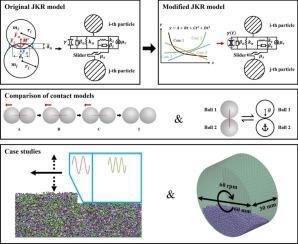A modified Johnson-Kendall-Roberts contact model for pavement engineering: Consideration of time-dependent surface energy
IF 4.6
2区 工程技术
Q2 ENGINEERING, CHEMICAL
引用次数: 0
Abstract
The Johnson-Kendall-Roberts (JKR) contact model is widely used in the discrete element method to simulate the dynamic behavior of particulate materials by assuming constant surface energy. However, under typical pavement conditions, such as asphalt mixture compaction and moist subgrade drying, particle surface energy varies with temperature and moisture content. This limits the accuracy of the traditional JKR model in capturing the evolution of inter-particle adhesion. To address this limitation, a time-dependent modified JKR contact model was proposed for pavement engineering applications. The modified model's performance was evaluated through a ball–ball pull-off test and validated via a ball gravity loading test based on the conservation of energy. Further, the case studies of pre-compaction and particle dewatering in pavement engineering were conducted using the modified JKR contact model. Results show that, under four different conditions, the compaction impulse increased by 15.57 %, 14.54 %, 13.04 %, and 14.87 %, indicating that the traditional model underestimates the additional compaction energy caused by enhanced adhesion and fails to accurately guide temperature control during compaction. For particle dewatering, the angle of repose decreased from 48.4° to 37.7°, reflecting the transition from a flowable to a stable particle structure. This enables better identification of the optimal construction window during the drying of subgrade materials. Overall, this study enhances the accuracy and applicability of the JKR contact model in pavement engineering by capturing dynamic adhesive behavior more realistically.

一种改进的路面工程Johnson-Kendall-Roberts接触模型:考虑时变表面能
Johnson-Kendall-Roberts (JKR)接触模型被广泛应用于离散元法中,通过假设表面能恒定来模拟颗粒材料的动态行为。然而,在典型的路面条件下,如沥青混合料压实和潮湿路基干燥,颗粒表面能随温度和含水率而变化。这限制了传统JKR模型在捕捉粒子间粘附演化过程中的准确性。为了解决这一限制,提出了一种用于路面工程应用的时变修正JKR接触模型。修正模型的性能通过球-球拉脱试验进行了评价,并通过基于能量守恒的球重力加载试验进行了验证。采用改进的JKR接触模型对预压实和颗粒脱水在路面工程中的应用进行了实例研究。结果表明,在4种不同条件下,压实冲量分别增加了15.57%、14.54%、13.04%和14.87%,说明传统模型低估了因黏附增强而产生的额外压实能量,不能准确指导压实过程中的温度控制。颗粒脱水时,休止角由48.4°减小到37.7°,反映了颗粒结构由可流动向稳定过渡。这样可以更好地确定路基材料干燥过程中的最佳施工窗口。总体而言,本研究通过更真实地捕捉动态粘接行为,提高了JKR接触模型在路面工程中的准确性和适用性。
本文章由计算机程序翻译,如有差异,请以英文原文为准。
求助全文
约1分钟内获得全文
求助全文
来源期刊

Powder Technology
工程技术-工程:化工
CiteScore
9.90
自引率
15.40%
发文量
1047
审稿时长
46 days
期刊介绍:
Powder Technology is an International Journal on the Science and Technology of Wet and Dry Particulate Systems. Powder Technology publishes papers on all aspects of the formation of particles and their characterisation and on the study of systems containing particulate solids. No limitation is imposed on the size of the particles, which may range from nanometre scale, as in pigments or aerosols, to that of mined or quarried materials. The following list of topics is not intended to be comprehensive, but rather to indicate typical subjects which fall within the scope of the journal's interests:
Formation and synthesis of particles by precipitation and other methods.
Modification of particles by agglomeration, coating, comminution and attrition.
Characterisation of the size, shape, surface area, pore structure and strength of particles and agglomerates (including the origins and effects of inter particle forces).
Packing, failure, flow and permeability of assemblies of particles.
Particle-particle interactions and suspension rheology.
Handling and processing operations such as slurry flow, fluidization, pneumatic conveying.
Interactions between particles and their environment, including delivery of particulate products to the body.
Applications of particle technology in production of pharmaceuticals, chemicals, foods, pigments, structural, and functional materials and in environmental and energy related matters.
For materials-oriented contributions we are looking for articles revealing the effect of particle/powder characteristics (size, morphology and composition, in that order) on material performance or functionality and, ideally, comparison to any industrial standard.
 求助内容:
求助内容: 应助结果提醒方式:
应助结果提醒方式:


